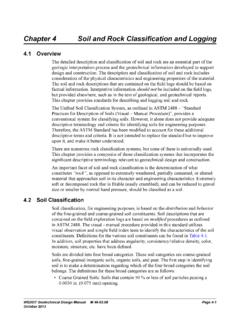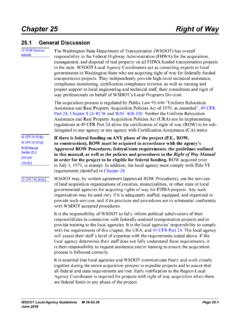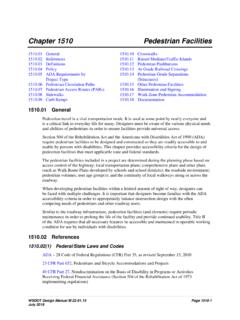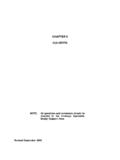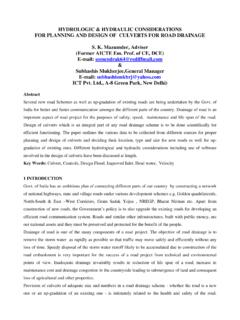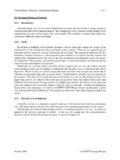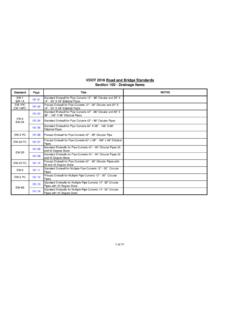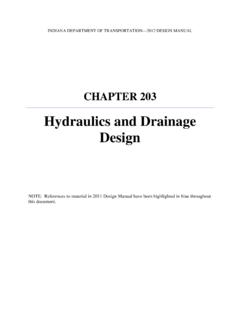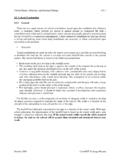Transcription of Chapter 4 Drainage - Washington State Department of ...
1 Chapter 4 Drainage4-1 GeneralManaging water on the right of way requires a Drainage system that effectively responds to the immediate environment. A typical highway Drainage system includes conveyances of all types: gutters, drains, ditches, culverts, storm sewers, and other miscellaneous Drainage structures. The system is designed and constructed to collect, treat, and remove storm water from the highway right of way. It must be properly maintained to: Permit the maximum use of the roadway. Prevent damage to the highway structure. Protect natural resources. Protect abutting property from physical damage. Comply with applicable storm water management facilities should be maintained as nearly as possible to the condition and at the capacity for which they were originally designed and constructed.
2 The entire Drainage system should be generally inspected at least twice a year or otherwise based on specific environmental permit requirements, past experience, and professional judgement. Deficiencies should be corrected when they are discovered. Additional inspections may be required during heavy storms and periods of high runoff in order to determine the effectiveness of the system. High water marks should be observed and recorded as well as conditions that threaten damage to the Drainage facility or the highway. Maintenance personnel must be continually alert to assure that all natural water course channels crossing the right of way remain open. WSDOT policy regarding accommodation of Storm water Runoff onto Right of Way is outlined in Policy Statement Number P 2032 dated February 10, 2012.
3 This policy clarifies the departments responsibility for establishing and maintaining storm water management systems for its highways and other facilities that adequately manage the volumes and quality of storm water according to standards contained within the Highway Runoff Manual M Maintenance Manual M Page 4-1 September 20204-2 Drainage From Abutting PropertiesStorm water is the only effluent allowed to be discharged upon the highway right of way. RCW allows persons and entities who have been issued utility franchises or permits to encroach on or cross highway right of way to install and maintain the item for which the permit was growth, urban sprawl, and numerous new regulations restrict how maintenance crews can maintain surface and subsurface Drainage systems.
4 Regulations that may affect Drainage maintenance include: Endangered Species Act Federal Clean Water Act National Pollutant Discharge Elimination System (NPDES) Storm Water Management Wetlands Preservation WDFW Hydraulic Rules Growth Management Act Shoreline Management Act Irrigation LimitationsIt is important that the Washington State Department of Transportation (WSDOT) not allow abutting property owners to discharge water onto the highway right of way without obtaining a permit. Property owners may obtain permits by applying at the WSDOT area or region office. Drainage design engineers and maintenance staff review potential Drainage impacts from the abutting property to the highway right of way. The property owner may be required to mitigate water quality and/or quantity impacts to obtain a personnel who routinely patrol a roadway section must be trained in the basic knowledge of what types of direct Drainage and sheet flow from abutting property may require a permit.
5 These include new: Commercial developments such as shopping centers Subdivisions Industrial development Automobile wrecking yards Dairy and other intensive farming personnel should report land use changes they observe to their supervisor. The supervisor will forward this information to the appropriate 4 DrainagePage 4-2 WSDOT Maintenance Manual M September 20204-3 Ditches and GuttersOpen ditches should be routinely checked and maintained as close as possible to the line, grade, depth, and cross section to which they were constructed. Vegetation in ditches often helps prevent erosion and treats storm water. Remove vegetation only when flow is blocked or excess sediments have accumulated. Remove vegetation using best management practices that minimize erosion and sediment escape to water erosion of Drainage ditches must be controlled or repaired.
6 Ditch linings of loose or grouted rock and concrete or other energy dissipation methods can control erosion. However, these linings need be checked frequently and repaired as ditches and gutters free of litter and debris. Repair cracks and breaks as especially careful when chemicals are used for brush and grass control in open ditches. Herbicides must be carefully controlled so as not to contaminate water or to transfer and concentrate chemicals in adjacent areas where environmental damage may result. Always follow product application alert for diversion ditches on top of cut slopes that prevent slope erosion by intercepting surface Drainage . Diversion ditches must be maintained to retain their diversion shape and material that results from ditch cleaning can often be used for widening.
7 Material placed into the adjacent portions of the highway or disposal areas must not obstruct or impair other roadside Drainage areas. Do relocate material that may cause sedimentation problems into water bodies. Take care to avoid causing erosion problems or loose unstable fills. Do not use non-porous materials such as clay. They can become unstable when wet and trap water in the existing fill. If there is doubt about using such surplus material, contact the Region Soils Engineer for assistance and consult with your Region Maintenance Environmental not blade ditch cleanings across roadway surfaces. Dirt and debris remaining on the pavement after ditch cleaning operations must be swept from the undercutting the roadway back slope or in slope.
8 Undercutting weakens the slope and will cause damaging slip-outs and other forms of slope Rockfall Ditches and Slope BenchesKeep rock fall ditches and slope benches clean. Large amounts of slough or rock fall and other slide material that effectively block the ditch or bench should be removed as soon as Chapter 4 WSDOT Maintenance Manual M Page 4-3 September 20204-5 Dry WellsDry wells accommodate the Drainage flow in certain areas where: Natural outfalls for a Drainage system were not available. Their use reduces the need for or size of downstream dry wells should be inspected periodically. Replace the drain rock if storm water no longer percolates into the soil. Within NPDES permit coverage areas, dry wells must be inspected annually and maintained to the applicable standards found in the Highway Runoff Manual M 31-16.
9 Inspection frequencies may be revised in accordance with NPDES permit provisions. Inspection and maintenance work completed on dry wells within NPDES permit coverage areas must be documented in the Highway Activity Tracking System (HATS) to meet annual reporting CulvertsA culvert is a closed conduit under a roadway or embankment used to maintain flow from a natural channel or Drainage ditch. A culvert should convey flow without causing damaging backwater, excessive flow constriction, or excessive outlet velocities. WSDOT s highway culvert inventory is managed in HATS. WSDOT is responsible for maintaining culverts that cross under State owned highways and culverts under county road approaches. Culverts under approaches to city streets that are designated as part of the highway system are the responsibility of the city under RCW and as clarified under the current City State Guidelines.
10 Culverts under privately owned roads are the responsibility of the private property owner per the provision of access connection permits referenced within WAC 468-51 080 (3). As a general guideline, culverts should be inspected twice a year, once before the fall/winter storms and once after the rainy season has ended to ensure they are clean and in good operating condition. Culverts may be inspected more or less than this frequency based on the past history of the particular routine culvert inspection form is found in HATS and shall be used to document certain deficiencies that necessitate culvert cleaning and repair. A level 1 inspection form is found in HATS and shall be used to rate the condition of the culvert feature as well as document certain deficiencies identified during the inspection that require further action including cleaning, repair, and notification to region hydraulic program to perform a level 2 inspection.






